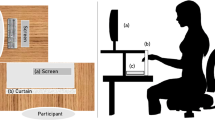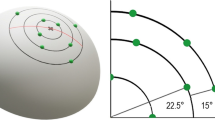Abstract
We used a haptic enumeration task to investigate whether enumeration can be facilitated by perceptual grouping in the haptic modality. Eight participants were asked to count tangible dots as quickly and accurately as possible, while moving their finger pad over a tactile display. In Experiment 1, we manipulated the number and organization of the dots, while keeping the total exploration area constant. The dots were either evenly distributed on a horizontal line (baseline condition) or organized into groups based on either proximity (dots placed in closer proximity to each other) or configural cues (dots placed in a geometric configuration). In Experiment 2, we varied the distance between the subsets of dots. We hypothesized that when subsets of dots can be grouped together, the enumeration time will be shorter and accuracy will be higher than in the baseline condition. The results of both experiments showed faster enumeration for the configural condition than for the baseline condition, indicating that configural grouping also facilitates haptic enumeration. In Experiment 2, faster enumeration was also observed for the proximity condition than for the baseline condition. Thus, perceptual grouping speeds up haptic enumeration by both configural and proximity cues, suggesting that similar mechanisms underlie perceptual grouping in both visual and haptic enumeration.



Similar content being viewed by others
References
Allen, R., & McGeorge, P. (2008). Enumeration: Shape information and expertise. Acta Psychologica, 129, 26–31. doi:10.1016/j.actpsy.2008.04.003
Beckwith, M., & Restle, F. (1966). Process of enumeration. Psychological Review, 73, 437–444. doi:10.1037/h0023650
Bozzi, P., & Vicario, G. (1960). Due fattori di unificazione fra note musicali: La vicinanza temporale e la vicinanza tonale. Rivista di Psicologia, 54, 253–258.
Camos, V., & Tillmann, B. (2008). Discontinuity in the enumeration of sequentially presented auditory and visual stimuli. Cognition, 107, 1135–1143. doi:10.1016/j.cognition.2007.11.002
Chang, D., Nesbitt, K. V., & Wilkins, K. (2007). The Gestalt principles of similarity and proximity apply to both the haptic and visual grouping of elements. Paper presented at Eight Australian User Interface Conference (AUIC2007), Ballarat, Australia. Retrieved from http://dl.acm.org/citation.cfm?id=1273727
Frings, C., & Spence, C. (2013). Gestalt grouping effects on tactile information processing: When touching hands override spatial proximity. Attention, Perception, & Psychophysics, 75, 468–480. doi:10.3758/s13414-012-0417-6
Gallace, A., & Spence, C. (2011). To what extent do Gestalt grouping principles influence tactile perception? Psychological Bulletin, 137, 538–561. doi:10.1037/a0022335
Kaufman, E. L., Lord, M. W., Reese, T. W., & Volkmann, J. (1949). The discrimination of visual number. American Journal of Psychology, 62, 498–525. doi:10.2307/1418556
Koffka, K. (1922). Perception: An introduction to the Gestalt-theory. Pychological Bulletin, 19, 531–585. doi:10.1037/h0072422
Krajcsi, A., Szabó, E., & Mórocz, I. Á. (2013). Subitizing is sensitive to the arrangement of objects. Experimental Psychology, 60, 227–234. doi:10.1027/1618-3169/a000191
Kubovy, M., & van den Berg, M. (2008). The whole is equal to the sum of its parts: A probabilistic model of grouping by proximity and similarity in regular patterns. Psychological Review, 115, 131–154. doi:10.1037/0033-295X.115.1.131
Luna, D., & Montoro, P. R. (2011). Interactions between intrinsic principles of similarity and proximity and extrinsic principle of common region in visual perception. Perception, 40, 1467–1477. doi:10.1068/p7086
Mandler, G., & Shebo, B. J. (1982). Subitizing: An analysis of its component processes. Journal of Experimental Psychology: General, 111, 1–22. doi:10.1037/0096-3445.111.1.1
Oshima, K., & Ichihara, S. (2012). How finger movement speed affects braille pattern recognition. In P. Isokoski & J. Springare (Eds.), Haptics: Perception, devices, mobility, and communication: Proceedings of the International Conference, EuroHaptics 2012, Tampere, Finland, June 13–15, 2012 (pp. 115–120). Heidelberg, Germany: Springer.
Overvliet, K. E., Krampe, R. T., & Wagemans, J. (2012). Perceptual grouping in haptic search: The influence of proximity, similarity, and good continuation. Journal of Experimental Psychology: Human Perception and Performance, 38, 817–821. doi:10.1037/a0029222
Overvliet, K. E., Krampe, R. T., & Wagemans, J. (2013). Grouping by proximity in haptic contour detection. PloS One, 8, e65412. doi:10.1371/journal.pone.0065412
Overvliet, K. E., Mayer, K. M., Smeets, J. B. J., & Brenner, E. (2008). Haptic search is more efficient when the stimulus can be interpreted as consisting of fewer items. Acta Psychologica, 127, 51–56. doi:10.1016/j.actpsy.2007.01.001
Overvliet, K. E., Smeets, J. B., & Brenner, E. (2007a). Haptic search with finger movements: Using more fingers does not necessarily reduce search times. Experimental Brain Research, 182, 427–434. doi:10.1007/s00221-007-0998-9
Overvliet, K. E., Smeets, J. B. J., & Brenner, E. (2007b). Parallel and serial search in haptics. Perception & Psychophysics, 69, 1059–1069. doi:10.3758/BF03193944
Plaisier, M. A., Bergmann Tiest, W. M., & Kappers, A. M. (2009). One, two, three, many—Subitizing in active touch. Acta Psychologica, 131, 163–170. doi:10.1016/j.actpsy.2009.04.003
Plaisier, M. A., Bergmann Tiest, W. M., & Kappers, A. M. (2010a). Range dependent processing of visual numerosity: Similarities across vision and haptics. Experimental Brain Research, 204, 525–537. doi:10.1007/s00221-010-2319-y
Plaisier, M. A., & Smeets, J. B. (2011). Haptic subitizing across the fingers. Attention, Perception, & Psychophysics, 73, 1579–1585. doi:10.3758/s13414-011-0124-8
Plaisier, M. A., van’t Woud, M., & Kappers, A. M. (2011). The effect of feature saliency on haptic subitizing. Experimental Brain Research, 209, 29–34. doi:10.1007/s00221-010-2517-7
Plaisier, M. A., Bergmann Tiest, W. M., & Kappers, A. M. (2010b). Grabbing subitizing with both hands: Bimanual number processing. Experimental Brain Research, 202, 507–512. doi:10.1007/s00221-009-2146-1
Riggs, K. J., Ferrand, L., Lancelin, D., Fryziel, L., Dumur, G., & Simpson, A. (2006). Subitizing in tactile perception. Psychological Science, 17, 271–272. doi:10.1111/j.1467-9280.2006.01696.x
Scholtz, D. A. (1957). Die Grundsätze der Gestaltwahrnehmung in der Haptik [Fundamental principles of form perception in touch]. Acta Psychologica, 13, 299–333. doi:10.1016/0001-6918(57)90029-x
Sherrick, C. E., & Cholewiak, R. W. (1986). Cutaneous sensitivity. In K. Boff, L. Kaufman, & J. Thomas (Eds.), Handbook of perception and human performance (pp. 1–70). New York, NY: Wiley.
van Oeffelen, M. P., & Vos, P. G. (1982). Configurational effects on the enumeration of dots: Counting by groups. Memory & Cognition, 10, 396–404. doi:10.3758/BF03202432
Wagemans, J., Elder, J. H., Kubovy, M., Palmer, S. E., Peterson, M. A., Singh, M., & von der Heydt, R. (2012a). A century of Gestalt psychology in visual perception: I. Perceptual grouping and figure–ground organization. Psychological Bulletin, 138, 1172–1217. doi:10.1037/a0029333
Wagemans, J., Feldman, J., Gepshtein, S., Kimchi, R., Pomerantz, J. R., van der Helm, P. A., & van Leeuwen, C. (2012b). A century of Gestalt psychology in visual perception: II. Conceptual and theoretical foundations. Psychological Bulletin, 138, 1218–1252. doi:10.1037/a0029334
Wender, K. F., & Rothkegel, R. (2000). Subitizing and its subprocesses. Psychological Research, 64, 81–92. doi:10.1007/s004260000021
Wertheimer, M. (1912). Experimentelle Studien über das Sehen von Bewegung. Zeitschrift für Psychologie, 61, 161–265.
Wertheimer, M. (1923). Untersuchungen zur Lehre von der Gestalt: II. Psychologische Forschung, 4, 301–350. doi:10.1007/BF00410640
Author note
The authors were supported by a postdoctoral fellowship from the Fund for Scientific Research–Flanders, awarded to K.E.O. (FWO-1.2.610.11.N.00), and by long-term structural funding from the Flemish government (METH/08/02), awarded to J.W.
Author information
Authors and Affiliations
Corresponding author
Appendices
Appendix A: Visual representation of the stimuli used in Experiment 1


Appendix B

Appendix C: Visual representation of the stimuli used in Experiment 2



Appendix D

Rights and permissions
About this article
Cite this article
Verlaers, K., Wagemans, J. & Overvliet, K.E. The effect of perceptual grouping on haptic numerosity perception. Atten Percept Psychophys 77, 353–367 (2015). https://doi.org/10.3758/s13414-014-0770-8
Published:
Issue Date:
DOI: https://doi.org/10.3758/s13414-014-0770-8




